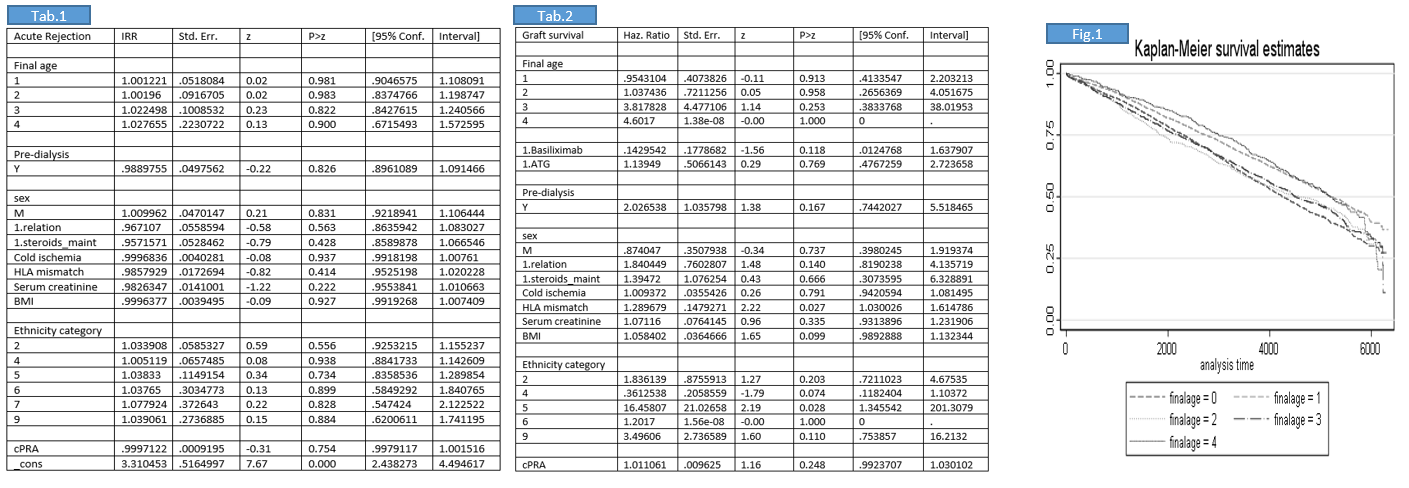Outcome of Large Donor-Recipient Age Gap in Live-Donor Renal Transplant in Tacrolimus Era
1Medicine, Medical University of South Carolina, Charleston, SC, 2Medicine, Cairo University, Cairo, Egypt, 3Surgery, Medical University of South Carolina, Charleston, SC, 4Medicine, Royal Stoke University, Royal Stoke, United Kingdom
Meeting: 2020 American Transplant Congress
Abstract number: A-080
Keywords: Age factors, Living donor, Risk factors
Session Information
Session Name: Poster Session A: Kidney Living Donor: Selection
Session Type: Poster Session
Date: Saturday, May 30, 2020
Session Time: 3:15pm-4:00pm
 Presentation Time: 3:30pm-4:00pm
Presentation Time: 3:30pm-4:00pm
Location: Virtual
*Purpose: A large donor-to-recipient age gap among deceased-donor renal transplant (RT) patients leads to worse outcomes. However, the impact of this age gap among live-donor RT is less clear. This study aimed to assess the effect of age gap on graft survival and acute rejection rates among RT in tacrolimus era.
*Methods: A total of 14,390 live-donor RT recipients who received a single organ transplant, had no previous RT, discharged on tacrolimus-based immunotherapy and registered in the Organ Procurement Transplantation Network from January 2000 till June 2017 were included in the study. Subjects were divided into 5 groups based on donor-recipient age difference; group A (difference <−10, n=4,375), group B (difference from -10 to 10, n=7,229), group C (difference between 10-20, n=861), group D (difference between 20-29, n=1,406) and group E (difference ≥30 years, n=519). Poisson regression analysis was used to assess effect of age gap on acute rejection rates (Tab.1). Kaplan-Meier survival curves (Fig.1) and Cox hazard regression analysis were used to assess this effect on graft survival (Tab.2).
*Results: Regarding graft survival, groups with age difference ≥30 years and between 20-29 years showed a significantly higher risk of graft loss when compared to group with age difference <−10 (HR equals 4.6 and 3.8 respectively). Groups with age difference between 10 to 20 years and between -10 to 10 years showed no significant difference in graft survival when compared to same group (HR equals 1.03 and 0.95 respectively). Groups B,C,D,E had similar rate of acute rejection episodes when compared to group A (IRR=1.001, 1.001, 1.022, 1.027 respectively).
*Conclusions: Donor-recipient age difference up to 20 years has similar RT outcomes to those receiving kidneys from younger donors and therefore, should not be precluded from paired kidney donation programs. The donor-recipient age difference >20 years is associated with worse outcomes in terms of graft survival.
To cite this abstract in AMA style:
Soliman K, Fulop T, Ahmed MMohamed, Osman A, Posadas A, Casey M, Rao V, Rohan V, Dubay D, Nadig S, Ali H. Outcome of Large Donor-Recipient Age Gap in Live-Donor Renal Transplant in Tacrolimus Era [abstract]. Am J Transplant. 2020; 20 (suppl 3). https://atcmeetingabstracts.com/abstract/outcome-of-large-donor-recipient-age-gap-in-live-donor-renal-transplant-in-tacrolimus-era/. Accessed December 25, 2025.« Back to 2020 American Transplant Congress

